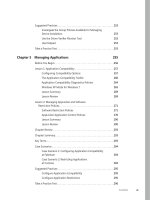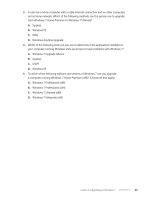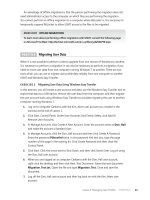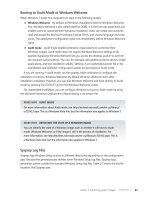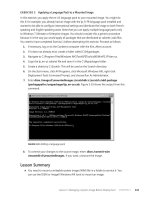Configuring Windows 7 (Training Kit) - Part 22 ppsx
Bạn đang xem bản rút gọn của tài liệu. Xem và tải ngay bản đầy đủ của tài liệu tại đây (189.7 KB, 10 trang )
Lesson 2: Deploying Images CHAPTER 3 183
10. Access C:\Windows 7\MDT 2010 Files. Check that all the specified files have been
downloaded to the subfolder folder Microsoft Deployment Toolkit 2010 Beta.
exercise 2 Accessing the MDT 2010 Documentation
Microsoft recommends that you read the MDT 2010 documentation before installing the tool.
To access this documentation, proceed as follows:
1. If necessary, log on to the Canberra computer with the Kim_Akers account.
2. Access the folder C:\Windows 7\MDT 2010 Files. Open the Microsoft Deployment
Toolkit 2010 Beta folder.
3. Double-click Quick Start Guide For Lite Touch Installation.docx and save the file to
C:\Windows 7\MDT 2010 Documentation.
4. Double-click Release Notes.docx and save the file to the same location.
5. Double-click What’s New In MDT 2010 Guide .docx and save the file to the same
location.
6. Read the downloaded documents carefully before you attempt Exercise 3 in this
practice session.
exercise 3 Installing MDT 2010
In this exercise, you install MDT 2010. This exercise assumes that you have installed the x86
version of Windows 7 Ultimate. If you have installed a 64-bit operating system, install the x64
version of MDT 2010 instead. To install MDT 2010, proceed as follows:
1. If necessary, log on to the Canberra computer with the Kim_Akers account.
2. Right-click the file MicrosoftDeploymentToolkit_x86.msi, which you downloaded in
Exercise 1 and choose Install.
3. On the Welcome page, click Next.
4. On the End-User License Agreement page, review the license agreement. If you agree
with the terms, select I Accept The Terms In The License Agreement, and then click
Next.
5. On the Custom Setup page, shown in Figure 3-37, choose the features to install and the
destination folder for the installation, and then click Next. The features are as follows:
n
Documents This feature installs the guidance and job aids. By default,
this feature is installed in C:\Program Files\Microsoft Deployment Toolkit\
Documentation. The prerequisites for installing this feature and using
Deployment Workbench to view the documentation are Microsoft .NET
Framework version 2.0 and MMC version 3.0, both of which are implemented in
Windows 7.
n
Tools and templates This feature installs the wizards and template
deployment files, such as Unattend.xml. By default, this feature is installed in
C:\Program Files\Microsoft Deployment Toolkit.
1 8 4 CHAPTER 3 Deploying System Images
FIGURE 3-37 Choosing the MDT features to install
6. If you want to change a feature’s state, click the feature, and then choose a state.
To change the destination folder, click Microsoft Deployment Toolkit, and then
click Browse. In the Change Current Destination Folder dialog box, specify the new
destination folder and then click OK.
7. Ensure Microsoft Development Toolkit is selected, as shown previously in Figure 3-37,
and click Install. If prompted, click Yes to allow the program to continue.
8. When installation completes, click Finish.
exercise 4 Creating a Distribution Share
In this exercise, you create a distribution share. You must have installed MDT 2010 before you
attempt this exercise. To create a distribution share, proceed as follows:
1. If necessary, log on to the Canberra computer with the Kim_Akers account.
2. On the Start menu, click All Programs. Click Microsoft Deployment Toolkit and then
choose Deployment Workbench. If necessary, click Yes to allow the program to make
changes to your computer.
3. In Deployment Workbench, right-click Distribution Share and then choose Create
Distribution Share Directory.
4. On the Specify Directory page of the Create Distribution Share Wizard, click Create A
New Distribution Share.
5. Type C:\Downloads in the Path For New Distribution Share Directory text box, as
shown in Figure 3-38, and then click Finish.
Lesson 2: Deploying Images CHAPTER 3 185
FIGURE 3-38 Specifying the path for the distribution share
6. Navigate to C:\Downloads and check that the folder is populated by subfolders, as
shown in Figure 3-39. Some of these folders (such as Applications) are initially empty;
others (such as Tools) are not.
FIGURE 3-39 Contents of a newly created distribution share
1 8 6 CHAPTER 3 Deploying System Images
exercise 5 Install an Image on the Distribution Share
In this exercise, you install the Windows 7 source files on the Windows 7 Installation media in
the distribution share that you created in the previous exercise. To install this image, proceed
as follows:
1. If necessary, log on to the Canberra computer with the Kim_Akers account.
2. Insert the Windows 7 x86 installation DVD-ROM. If necessary, close the AutoPlay
dialog box. As this exercise is written, the DVD-ROM drive is F:. If your computer uses
a different drive letter, amend the procedure accordingly.
3. If necessary, open Deployment Workbench.
4. Under Deployment Workbench, expand Distribution Share and select Operating
S y s t e m s .
5. In the Action pane, click New.
6. Ensure that Full Set Of Source Files is selected on the OS Type page of the New OS
Wizard, as shown in Figure 3-40. You could also specify a Custom Image file, such
as the Myimage.wim file that you captured and deployed on your bootable VHD in
Chapter 2 or a WDS image available on a specified WDS server.
FIGURE 3-40 Specifying a full set of source files
7. Click Next.
Lesson 2: Deploying Images CHAPTER 3 187
8. On the Source page, type F: in the Source Directory text box. Click Next.
9. Ensure that Windows 7 x86 is entered in the Destination Directory Name text box and
click Finish.
10. The copy operation takes some time. When it is complete, ensure that the appropriate
operating system images have been placed in the distribution share, as shown in
Figure 3-41.
FIGURE 3-41 Operating system images placed in the distribution share
Lesson Summary
n
MDT 2010 enables you to manage and manipulate disk images and to create
a distribution share to distribute an operating system image to other computers on
your network. You need to install Windows AIK before you can create or deploy WIM
image files.
n
WDS uses boot images that enable PXE-compliant computers to boot from the
network and obtain an install image. If a computer is not PXE-compliant, you can boot
it from a discover image on bootable media and WDS can then deploy an install image
to it. Discover images enable you to boot a reference computer and transfer its system
image to WDS, which can then deploy it to other computers.
n
MDT 2010 can work with WDS in an LTI scenario. To implement ZTI, MDT 2010 requires
that SCCM 2007 and SQL Server are available on the network. MDT 2010 requires that
Windows AIK is installed.
1 8 8 CHAPTER 3 Deploying System Images
Lesson Review
You can use the following questions to test your knowledge of the information in Lesson 2,
“Deploying Images.” The questions are also available on the companion DVD if you prefer to
review them in electronic form.
note ANSWERS
Answers to these questions and explanations of why each answer choice is correct or
incorrect are located in the “Answers” section at the end of the book.
1. You want to ensure that offline VHD files that contain installations of Windows 7 are
kept up to date with service packs and software updates. Which tool should you use?
a. MDT 2010
B. Offline Virtual Machine Servicing Tool
c. BCDEdit
D. Configuration Manager 2007 R2
2. You want to deploy a WIM image file captured from a reference computer running
Windows 7. You need to specify the source directory in which the WIM file resides,
specify whether Setup or Sysprep files are required, and then move the file to the
distribution share. What tool lets you do this?
a. The Windows Deployment Services Image Capture Wizard, which is contained in
a WDS capture image
B. The New Task Sequence Wizard, which you can access from the SCCM 2007 Task
Sequence Editor
c. The Create Distribution Share Wizard, which you can access from the Deployment
Workbench console
D. The New OS Wizard, which you can access from the MDT 2010 Deployment
Workbench console
3. WDS creates install, boot, discover, and capture images. Which of these do you need to
install on bootable removable media?
a. Install
B. Boot (standard boot image)
c. Discover
D. Capture
4. Which of the following are required if WDS is to be installed and to deploy images?
(Choose all that apply.)
a. AD DS
B. MDT 2010
Lesson 2: Deploying Images CHAPTER 3 189
c. SQL Server
D. SCCM 2007
e. DHCP
F. DNS
5. You have created a bootable DVD-ROM containing a Windows PE image, the ImageX
tool, and a Windows 7 Ultimate Edition WIM image that you have captured from
a workstation on your SOHO network. You have used ImageX to install the image
on another computer. What tool do you use to configure that computer to boot from
the image?
a. BCDboot
B. DISM
c. BCDEdit
D. ImageX
1 9 0 CHAPTER 3 Deploying System Images
Chapter Review
To further practice and reinforce the skills you learned in this chapter, you can perform the
following tasks:
n
Review the chapter summary.
n
Review the list of key terms introduced in this chapter.
n
Complete the case scenarios. These scenarios set up real-world situations involving the
topics of this chapter and ask you to create a solution.
n
Complete the suggested practices.
n
Take a practice test.
Chapter Summary
n
You can use DISM or Image X to mount and unmount a system image. DISM adds
packages, drivers, and updates to a mounted image and obtains information about
online and offline-mounted system images. You can also use DISM to mount and
service Windows PE images.
n
MDT 2010 enables you to manage and manipulate disk images and to deploy them
to target computers through a distribution share. Windows AIK needs to be installed
before you can use MDT 2010 to deploy images.
n
WDS creates a boot menu that you can use from a PXE-compliant computer booted
from the network to install a system image to that computer. If a target computer is
not PXE-compliant, you can boot it from a discover image to access the boot menu.
A capture image is a type of boot image and appears on the boot menu. If you boot
a reference computer from a capture image, you can capture its system image and
copy it to a WDS server, which can in turn deploy it to other target computers.
n
You need MDT 2010 (and Windows AIK), along with SCCM 2007 and SQL Server, to
implement ZTI. You can implement LTI on PXE-compliant computers by using MDT
2010 and WDS.
Key Terms
Do you know what these key terms mean? You can check your answers by looking up the
terms in the glossary at the end of the book.
n
Boot image
n
Commit
n
Deploy
n
Distribution share
Case Scenarios CHAPTER 3 191
n
Install image
n
Mount
Case Scenarios
In the following case scenarios, you apply what you’ve learned about deploying system images.
You can find answers to these questions in the “Answers” section at the end of this book.
Case Scenario 1: Deploying an Image
with More Than One Language Pack
Don Hall, a systems administrator at Litware, Inc., has created a primary deployment image
for Litware’s client computers running Windows 7. He discovers that he needs to apply an
update, add a new driver, change settings, and support multiple languages. He wants to
make these changes without deploying the image and recapturing it. He also knows that if he
services the image offline, he is not required to run the Sysprep tool and therefore does not
need to use a rearm.
Litware is a relatively small organization with two locations. However, these two locations
are in different countries. Don has created a single master image so that he does not have
to maintain several variations. This image contains both the language packs that Litware
requires. Don needs to apply updates to the single image and ensure that all the updates are
applied to each language in the image. Before he deploys the image, he uses offline servicing
to remove the unnecessary language pack. He needs to service only Litware’s WIN image.
There is no requirement to service a Windows PE image.
Don intends to use the DISM tool to mount and service the offline image and then
unmount the image and commit his changes. He also wants to use DISM to create a report
about the state of the drivers, applications, language settings, and packages that are installed.
1. What does Don need to carry out these tasks?
2. What is the first thing Don needs to do with the master image?
3. What tasks does Don carry out using the DISM tool?
Case Scenario 2: Deploying an Image
to 100 Client Computers
You are a network administrator at Northwind Traders. Your company is expanding its Detroit
operation from a small branch office to a major facility, and you are tasked with deploying
100 client computers. The server infrastructure has already been upgraded. Detroit is part
of the Northwind Traders AD DS domain, and DHCP and DNS servers are available on the
Detroit subnet. The WDS server role has been installed and configured on a member server
running Windows Server 2008 R2 and a standard boot image has been created.
192 CHAPTER 3 Deploying System Images
You have been given a workstation running Windows 7 Enterprise that was previously
used by a staff member that has left the company. All personal files and non-mission-critical
applications have been stripped from the computer. Your boss wants all the new client
computers to be installed “just like that one.” The target computers are new machines and
easily meet the recommended Windows 7 Enterprise specifications. They are PXE-compliant.
1. What do you need to do to the workstation you have been given before you can use it
as a reference computer?
2. What do you need to create in WDS to enable you to obtain an image from the
reference computer?
3. How do you go about deploying the target computers?
Suggested Practices
To help you master the exam objectives presented in this chapter, complete the following
tasks.
Manage and Manipulate a System Image
Perform this practice exercise when logged on to the Canberra computer with the Kim_Akers
user account.
n
Use the DISM tool. Like all command-line tools, it might seem daunting to use at first,
but it becomes familiar with practice. Mount the image on your bootable VHD, use
all the Get options to obtain information, and then try all the configuration options.
Commit your amendments to the image, boot from the VHD, and see the result of
your changes.
Become Familiar with the Deployment Tools
Perform the first practice exercise when logged on to the Canberra computer with the Kim_
Akers user account. The second and third exercises are optional.
n
Practice 1 MDT is already installed on your Canberra computer. Use the tool to install
an operating system image, install drivers, install updates, install language packs, and
install applications. Create and edit task sequences and associate answer files with the
image.
n
Practice 2 Create a virtual PC running Windows 7. Deploy the system image that you
created in MDT and observe the results.
n
Practice 3 Create a virtual server running Windows Server 2008. Install the AD DS
server role and configure DHCP and DNS. Install the WDS role and practice using the
Windows Deployment Services console and the WDSUTIL command-line tool.

